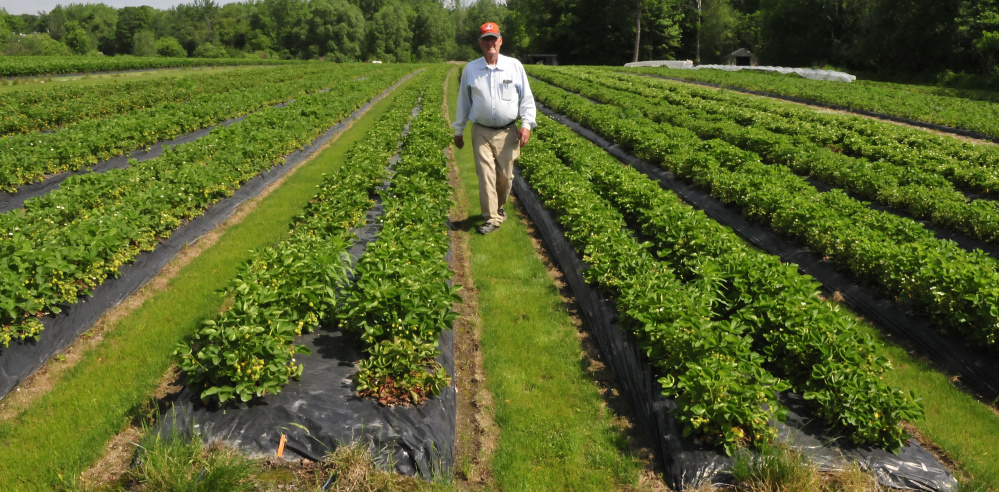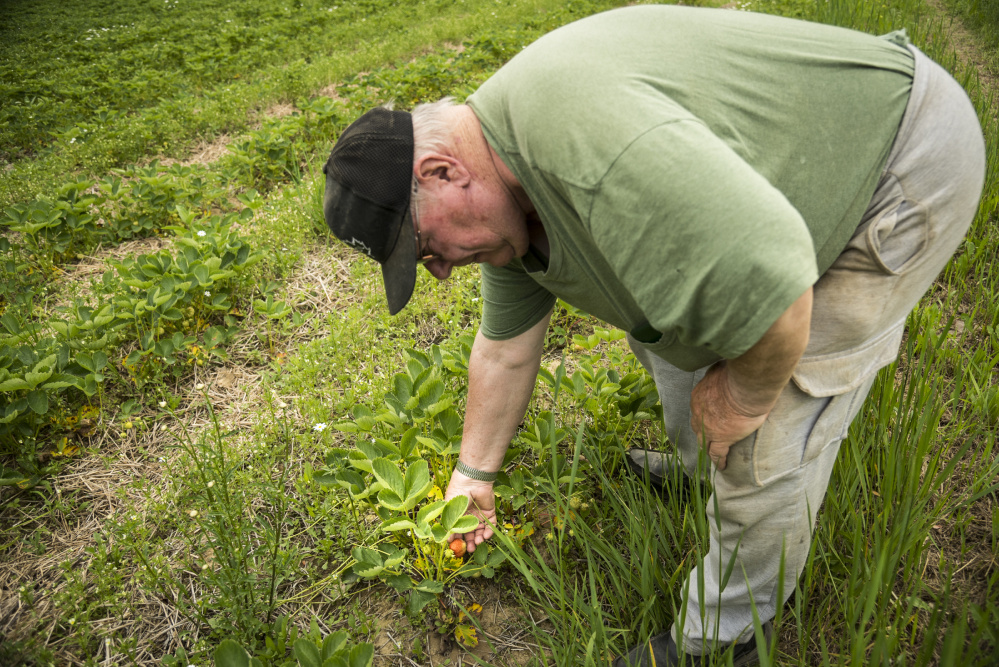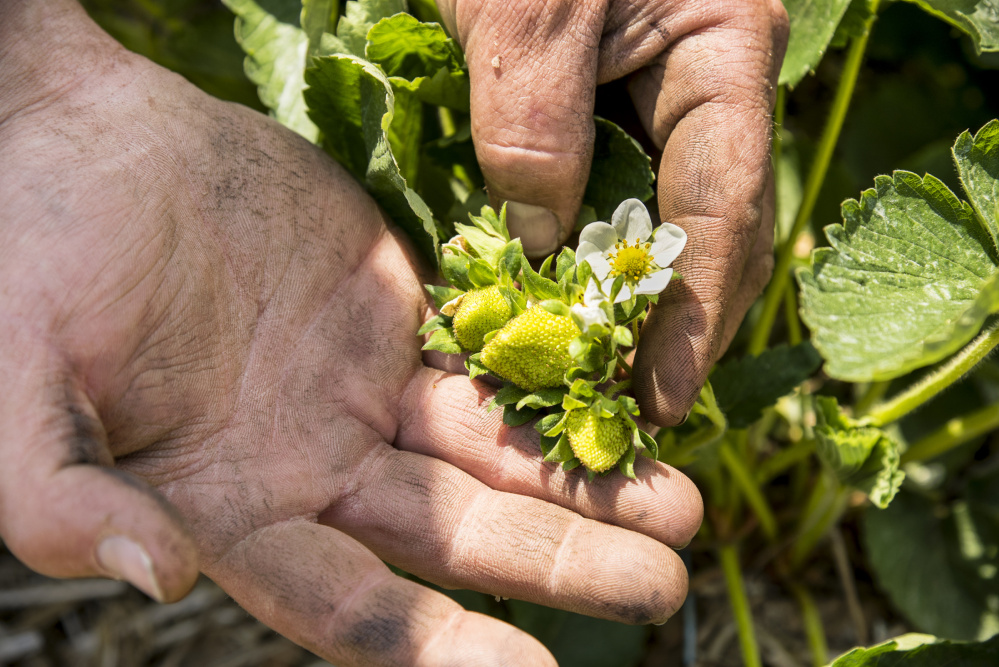While many Mainers were frustrated by the numerous snowstorms this winter, Tom Stevenson wasn’t one of them.
Stevenson runs Stevenson’s Strawberries in Wayne, and he said strawberries loved all that snow.
“Every inch is like putting a blanket on them,” he said. “It insulates them from the cold, cold temps over the winter, and you can’t ask for anything better than that.”
Because the temperature stayed relatively cool throughout May, Stevenson said, his workers are operating about four to seven days later than normal, but he said it’s OK with them.
“Right now, our plants look good,” he said.
David Handley, a vegetable and small fruit specialist for the University of Maine Cooperative Extension, said last summer’s drought had a big effect on the upcoming strawberry crop. The plant population is a little thinner because of the dry conditions last summer — except for those of growers with irrigation systems — but overall it looks good for the coming season.
He said demand for strawberries and compensating for last year isn’t what might cause an increase in price this year. Instead, growers’ rising business costs could trickle down to the consumer.
“Costs are going up with fertilizers, fuel to run the tractors and anything with energy,” Handley said. “And the cost of labor is going up because of the tight labor force. It’s the cost of doing business.”
According to the U.S. Department of Agriculture National Agricultural Statistics Service, the price per pound of strawberries in Maine in 2016 was $3.10, up from $2.65 the previous year; the New England average for 2016 was $2.90. The state yielded 5,550 pounds of strawberries per acre last year.
David Pike, who runs a small operation in Farmington, said the crop might be a bit behind schedule, but he is expecting a strong season.
“They’re coming along, and people say they will be late; but then again, we’ve had seasons where they say it’s early,” he said. “So it’ll probably just be closer to normal.”
He said despite the recent wet, cold weather, the disease pressure has been fairly low and his crops are looking good. He’s looking forward to the end of the school year because students pick his strawberries.
“I hope we get enough that we can start picking and selling (next week), but it’ll be a day-by-day basis,” Pike said. “We won’t be into full picking for another week, at least.”
As always, everything about strawberries — and most other crops — is dependent on the weather.
Strawberries are susceptible to frost when their blossoms are out, Stevenson said, so sometimes he’d have to get up at night and put water on the plants to keep a layer of ice on top to protect against frost. But because the snow melted a little later than normal, the blossoms emerged a little later, so that meant a lesser number of weeks Stevenson had to protect the plants from frost.
“They are ripening a little later than normal, but because of the winter and other conditions, the plants look dynamite,” he said.
Hot days like those most of Maine experienced earlier this week aren’t as much of a problem now, but they would be if berries already were on the plants. Cool, dry weather is great for the berries, Stevenson said, and that type of weather extends the picking season.
Despite the late start, Stevenson doesn’t expect to lose any days of picking, though he cautions that making predictions in his line of work is not foolproof. He said the picking season should last the same number of days as long as there aren’t a lot of hot days or long durations of wet weather.
“There are so many uncontrollable variables in agriculture, so you can’t really predict how business will be compared to last year,” he said. “But we will absolutely have more strawberries on the plant than last year.”
Stevenson said he hopes to open the farm for pickers at the end of the month. He said the prime time for picking strawberries should be early to mid-July.
“Our fruit load looks awesome, and hopefully Mother Nature will cooperate,” Stevenson said. “We should still be loaded.”
One interesting aspect of strawberry season, and other produce seasons, is the public disconnect that exists between the industry and some consumers. A major snowstorm might be a hassle for many people, but for strawberry growers, ski resorts and snowmobile companies, it’s a boon. On the other hand, a milder winter without a lot of snow is welcomed by some, but the flip side is the financial burden it places on those who rely on those kinds of conditions.
“People have become very disconnected from agriculture, and it’s not surprising, because when you go back two centuries, nearly 90 percent of the population was somehow involved in farming,” he said. “Fast-forward to us and you have less than 3 percent of the population farming.
“These people have no idea what it takes to grow crops and make a living from it,” he said.
Another point of disconnection happens when someone goes to a Maine grocery store in April and can buy as many strawberries as they please, yet they hear local farmers talking up the coming strawberry season.
“Someone ends up calling a grower asking if the strawberries are ready yet, but they won’t be ready until June,” he said. “The ones you’d see in the stores now are from California or Florida, so there’s a huge disconnect.” Especially in New England, he said, people have lost touch with the seasonality of agriculture.
Because produce is trucked all over the country, Handley said, people have lost that sense that it’s seasonal here.
“I’m not complaining, because if we stuck to our seasonal crops, you and I would spend most of the winter eating carrots and parsnips and potatoes,” he said.
In such a business, there’s only so much you can do to make sure you’re successful, Stevenson said. Every day, workers at Stevenson’s do everything they know will help.
“But there’s a certain leap of faith you have to take,” he said, laughing. “We do what we can, let Mother Nature handle the rest and hope she treats us OK.”
Jason Pafundi — 621-5663
jpafundi@centralmaine.com
Twitter: @jasonpafundiKJ
Send questions/comments to the editors.








